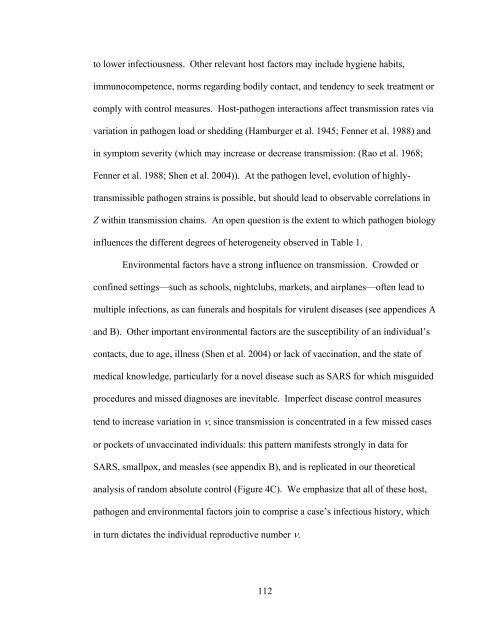K - College of Natural Resources - University of California, Berkeley
K - College of Natural Resources - University of California, Berkeley
K - College of Natural Resources - University of California, Berkeley
You also want an ePaper? Increase the reach of your titles
YUMPU automatically turns print PDFs into web optimized ePapers that Google loves.
to lower infectiousness. Other relevant host factors may include hygiene habits,<br />
immunocompetence, norms regarding bodily contact, and tendency to seek treatment or<br />
comply with control measures. Host-pathogen interactions affect transmission rates via<br />
variation in pathogen load or shedding (Hamburger et al. 1945; Fenner et al. 1988) and<br />
in symptom severity (which may increase or decrease transmission: (Rao et al. 1968;<br />
Fenner et al. 1988; Shen et al. 2004)). At the pathogen level, evolution <strong>of</strong> highly-<br />
transmissible pathogen strains is possible, but should lead to observable correlations in<br />
Z within transmission chains. An open question is the extent to which pathogen biology<br />
influences the different degrees <strong>of</strong> heterogeneity observed in Table 1.<br />
Environmental factors have a strong influence on transmission. Crowded or<br />
confined settings—such as schools, nightclubs, markets, and airplanes—<strong>of</strong>ten lead to<br />
multiple infections, as can funerals and hospitals for virulent diseases (see appendices A<br />
and B). Other important environmental factors are the susceptibility <strong>of</strong> an individual’s<br />
contacts, due to age, illness (Shen et al. 2004) or lack <strong>of</strong> vaccination, and the state <strong>of</strong><br />
medical knowledge, particularly for a novel disease such as SARS for which misguided<br />
procedures and missed diagnoses are inevitable. Imperfect disease control measures<br />
tend to increase variation in ν, since transmission is concentrated in a few missed cases<br />
or pockets <strong>of</strong> unvaccinated individuals: this pattern manifests strongly in data for<br />
SARS, smallpox, and measles (see appendix B), and is replicated in our theoretical<br />
analysis <strong>of</strong> random absolute control (Figure 4C). We emphasize that all <strong>of</strong> these host,<br />
pathogen and environmental factors join to comprise a case’s infectious history, which<br />
in turn dictates the individual reproductive number ν.<br />
112

















